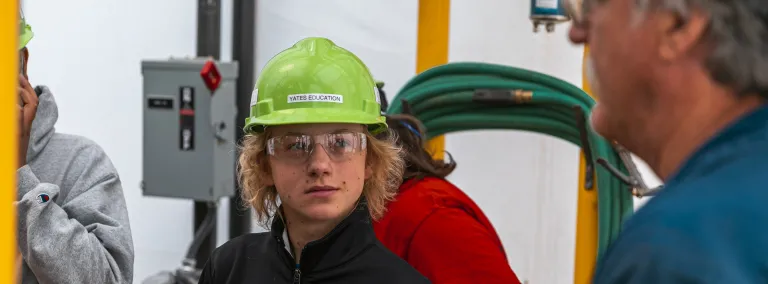Green Chemistry Camp learns about sustainability at Sanford Lab
High school students visit Sanford Lab’s WWTP as an example of environmentally responsible chemistry
On July 10, a group of high school students from across the United States toured Sanford Underground Research Facility’s (Sanford Lab) Waste Water Treatment Plant (WWTP) as a part of the Green Chemistry Camp hosted by the South Dakota School of Mines & Technology (SD Mines). The camp includes field trips, industry speakers and workshops to inspire high school students to explore scientific solutions to global sustainability challenges.
The WWTP at Sanford Lab is a perfect example of environmentally responsible chemistry practices. Students received a tour of the facility, which exhibits green initiatives, including reduced waste, strategic energy and chemical usage, and computer automated monitoring and control systems.
Ken Noren, foreman of the WWTP, described to the students some of the innovations the plant has adopted to reduce their operational waste. “We’ve cut almost a thousand kilowatts of power at any given time across the plant and reduced our chemical usage (including coagulants and flocculants) from 300 gallons every two weeks to only 200 gallons a year.”
Since Sanford Lab began operating in 2008, billions of gallons of water have been treated at the WWTP. More than half of that water is pumped from underground while the rest is added from the Grizzly Gulch tailings. Once treated, the water is released into Gold Run Creek, which joins Whitewood Creek within a few hundred yards of the discharge pipe.
Sanford Lab regularly monitors the health of the creeks, counting fish and macro invertebrate populations and tests for contaminants. In 2018, the WWTP was recognized for the tenth consecutive year by the South Dakota Department of Environment and Natural Resources (DENR) for their “outstanding operation of the wastewater system and environmental compliance” with DENR’s Surface Water Discharge Permit Award.
“This was a very engaged group that spanned multiple years of high school,” said Cabot-Ann Christofferson, researcher with the Majorana Demonstrator who lead part of with the student’s tour. “They showed a keen interest in how the WWTP worked and how it benefited the operations at Sanford Lab.”
The first Green Chemistry Camp took place in 2015. Since then, 66 students have taken part in this immersive learning experience.
“Students also had the opportunity to learn from guest speakers representing chemistry careers in industry, government and academia,” said Dr. Tsvetanka Filinova, director of the Green Chemistry Camp and senior lecturer of chemistry at SD Mines.
The students also took field trips to Midcontinent Testing Laboratory and Prairie Berry Winery to learn about the industrial systems used for green chemistry and participated in a full-schedule of hands-on workshops throughout the week.
